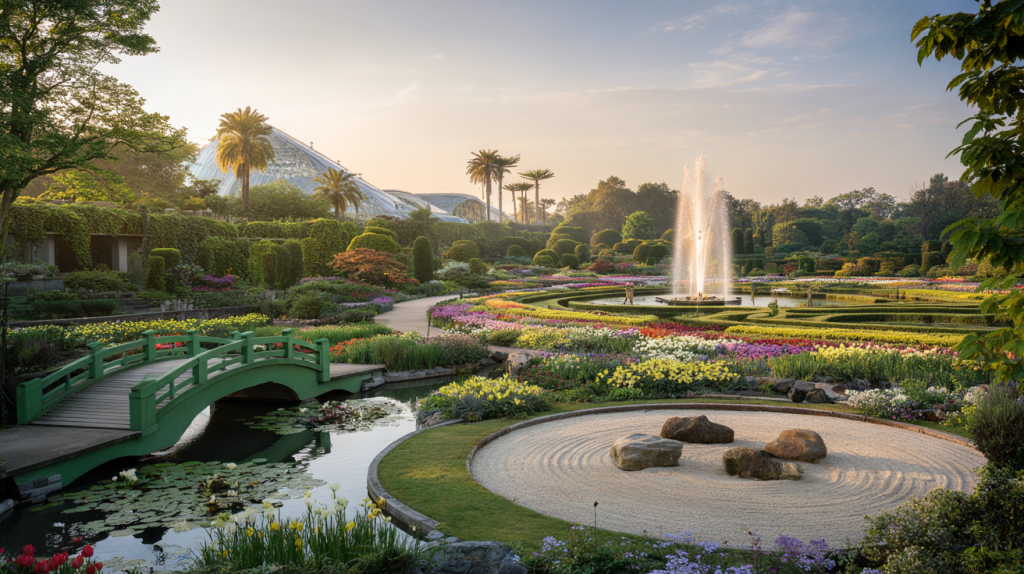Dreaming of a jaw-dropping garden trip : 10 standout gardens worldwide with key numbers, best seasons, and unique highlights. Europe to Asia to America.
Seven million tulips that bloom in just a few weeks. Steel trees rising 50 meters above a tropical bay. From royal parterres to Zen gravel, the world’s most beautiful gardens share one power : they stop time and flood the senses.
Here is a precise, field-tested selection spanning Europe, Asia, Africa and North America, with the right seasons to go and hard facts that separate must-see icons from pretty-but-forgettable parks. The goal : help plan an unforgetable visit, not a scroll.
Most Beautiful Gardens in the World : the quick shortlist
Looking for the fast answer before deep diving into details and dates ? Start here.
- Keukenhof, Netherlands – 7 million spring bulbs in 32 hectares, open March to May.
- Gardens by the Bay, Singapore – Supertrees up to 50 m and cool-climate domes.
- Royal Botanic Gardens, Kew, London – UNESCO site with 2.3 million visitors in 2022-23.
- Gardens of Versailles, France – Grand perspectives on an 800-hectare estate.
- The Butchart Gardens, Canada – 55 acres of color since 1904.
- Ryoan-ji, Kyoto, Japan – 15 stones in a 15th-century Zen masterpiece.
- Longwood Gardens, Pennsylvania, USA – 1,100 acres of horticultural theater.
- Kirstenbosch National Botanical Garden, South Africa – Indigenous flora at Table Mountain.
- Monet’s Garden at Giverny, France – Water lilies that shaped modern art.
- Dubai Miracle Garden, UAE – 150 million flowers, seasonal spectacle.
Europe’s icons : Keukenhof, Versailles, Kew and Giverny
Keukenhof turns spring into an event. Only open for roughly eight weeks from mid-March to mid-May, it plants about 7 million flower bulbs across 32 hectares each year, creating daily-changing mosaics of tulips, hyacinths and daffodils. Source : Keukenhof official site, 2024.
Versailles is garden as stagecraft. The estate covers about 800 hectares, with long axial views, groves and the Grand Canal designed for court festivities under King Louis XIV. Its fountain shows revive 17th-century water displays on set dates from spring to autumn. Source : Château de Versailles.
Kew blends science and beauty. The Royal Botanic Gardens span 132 hectares, hold one of the world’s largest and most diverse living plant collections, and have been a UNESCO World Heritage Site since 2003. Attendance reached around 2.3 million in 2022-23, a post-pandemic surge. Sources : UNESCO; Royal Botanic Gardens, Kew Annual Report 2022-23.
Giverny is intimate by design. Restored by the Fondation Claude Monet and open roughly April to November, the house and water garden show the Japanese bridge and lily pond that Monet painted in series from the 1890s. Source : Fondation Claude Monet.
From Asia to the Americas : futuristic domes, Zen stones and floral theaters
Singapore’s Gardens by the Bay rewrites what a garden can be. The 101-hectare site opened in 2012, with Supertrees rising 25 to 50 meters and two cooled conservatories. The Flower Dome was recognized by Guinness World Records as the world’s largest glass greenhouse in 2015. Sources : Gardens by the Bay; Guinness World Records, 2015.
Ryoan-ji in Kyoto is the opposite scale : a raked gravel rectangle and 15 stones placed so that only 14 are visible from any vantage point. The temple complex dates to the late 15th century and is inscribed as part of the Historic Monuments of Ancient Kyoto since 1994. Source : UNESCO World Heritage Centre.
In Canada, The Butchart Gardens grew from a reclaimed limestone quarry into 55 acres of display gardens, first planted in 1904. It now draws more than a million visitors annually, with standout spring blooms and summer evenings. Source : The Butchart Gardens.
Longwood Gardens near Philadelphia turns horticulture into spectacle. Founded by Pierre S. du Pont in 1906, the property extends across about 1,100 acres with seasonal displays, a grand conservatory and choreographed fountain performances that returned after a major revitalization in 2017. Source : Longwood Gardens.
Kirstenbosch, established in 1913 on the eastern slopes of Table Mountain, celebrates South Africa’s indigenous flora, from proteas to cycads. The sinuous Tree Canopy Walkway, opened in 2014, drifts above the arboretum for wide views over Cape Town. Source : South African National Biodiversity Institute.
Dubai Miracle Garden leans into scale : about 150 million flowers arranged as hearts, arches and full-size aircraft outlines during a seasonal window from autumn to spring, when temperatures allow outdoor bloom. Source : Dubai Miracle Garden.
How to plan a dream garden visit : seasons, crowds, budgets
Begin with timing. Keukenhof lives on a narrow window, and bloom peaks shift with weather. Versailles is best when its fountains run on scheduled days. Gardens by the Bay solves tropical heat with cooled domes, making midday visits realistic.
A common headache : crowd crunch. Kew’s attendance climbed sharply in 2022-23 after reopenings. Early entry or late afternoons often halve waiting lines for glasshouses and special groves. Source : Royal Botanic Gardens, Kew Annual Report 2022-23.
Think in layers, not just flowers. Ryoan-ji offers silence at opening time, when the raked gravel reads like a canvas. Longwood’s evening fountains turn planting schemes into night theater. Kirstenbosch pairs flora with mountain trails and shaded lawns, a relief on hot days.
Budget follows design. Free parkland surrounds some sites, but icons charge for conservation and operations. Check official sites the week before travel : hours, fountain dates, dome closures and seasonal plantings change, sometimes overnight. And if a single choice feels impossible, pair opposites on one trip – one formal European parterre and one contemporary greenhouse – for a complete view of how gardens keep evolving.
